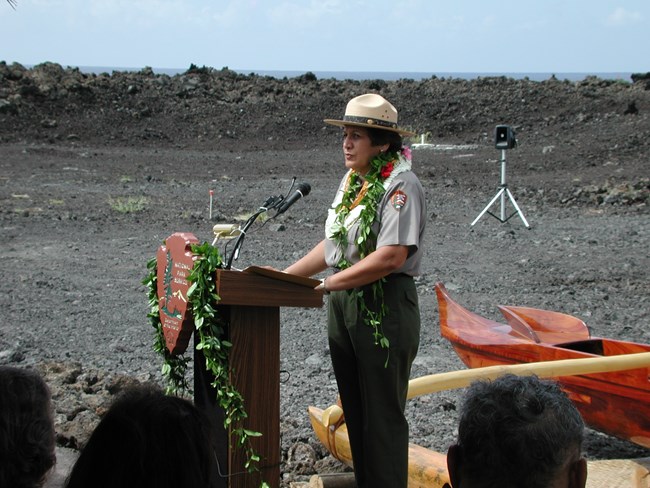Part of a series of articles titled Women's History in the Pacific West - Pacific Islands Collection.
Previous: Queen Lili'uokalani
Next: Olivia Robello Breitha
Article

NPS photo
Geraldine Kenui Bell, better known as Geri, was the first Native Hawaiian woman to be superintendent of a National Park Service (NPS) unit – in fact, she oversaw the operation of two different parks in Hawai‘i simultaneously. Through her job and community work, Bell has advocated for the celebration and protection of Hawaiian culture for current and future generations of Kānaka Maoli (Native Hawaiians).
Born the daughter of a blacksmith for the Hawaiian Commercial and Sugar Co. in the late 1940s, Bell grew up in a large family on Maui.1 Even as an adolescent she was interested in Hawaiian culture and belonged to her high school’s Hawaiiana club.2 After graduating from Maui Community College, Bell took a job as an information receptionist at the Haleakala National Park on Maui, beginning a 43-year-long career with the park service.3 Bell worked her way up through the ranks and later served as a mentor to other young women embarking on careers with the park service.4 She transferred to a secretary role at the NPS’s Honolulu office in 1970 and was promoted a few years later to the positions of Budget and Program Specialist and Administrative Officer.5 While in Honolulu, her husband, Jimmy Bell, worked as a police sergeant and the couple raised three children, David, Jamie, and Jalene.6
The family moved to the Big Island in 1997 when Geri Bell became superintendent of Pu‘uhonua O Hōnaunau National Historic Park.7 Two years later, she also assumed responsibility for Kaloko-Honokōhau National Historic Park, due to the cultural connections between the two sites.8 As only the second superintendent of Kaloko-Honokōhau, Bell directed the final phase of land acquisition and championed park-specific natural and archeological resource management.9 In 2002, Bell helped expand Pu‘uhonua O Hōnaunau to nearly double its size with the addition of the Kiʻilae area. Its rich landscape represented important archeological materials, cultural sites and features.10
Bell’s leadership style strengthened working relationships between employees of the park service and Kānaka Maoli community members.11 As superintendent, she prioritized the repatriation of the iwi kupuna (ancestral bones) in the Pu‘uhonua O Hōnaunau’s museum accessions records. Bell worked with descendants, other Native Hawaiian organizations, and the Hawai‘i Island Burial Council (which she later served on for eight years) to repatriate the iwi kupuna in a culturally respectful manner.12 Bell’s service to her community continued even after her retirement from the NPS in 2010. She is a longtime volunteer for the Association of Hawaiian Civic Clubs, the Annunciation Catholic Church, and Tutu’s House, a nonprofit that promotes health and wellness.13
Geri Bell’s leadership in cultural preservation has had a broad impact on the parks as well as her coworkers and community. When awarding Bell the Kukui Lama Kū Award (which recognizes the lifetime contributions of a civic club member) in 2019, the Association of Hawaiian Civic Clubs described her as follows: “Aunty Geri epitomizes the lama kū (a strong torch that guides) fueled by the kukui (a tree from the ancient past).”14
Part of a series of articles titled Women's History in the Pacific West - Pacific Islands Collection.
Previous: Queen Lili'uokalani
Next: Olivia Robello Breitha
Last updated: February 22, 2022